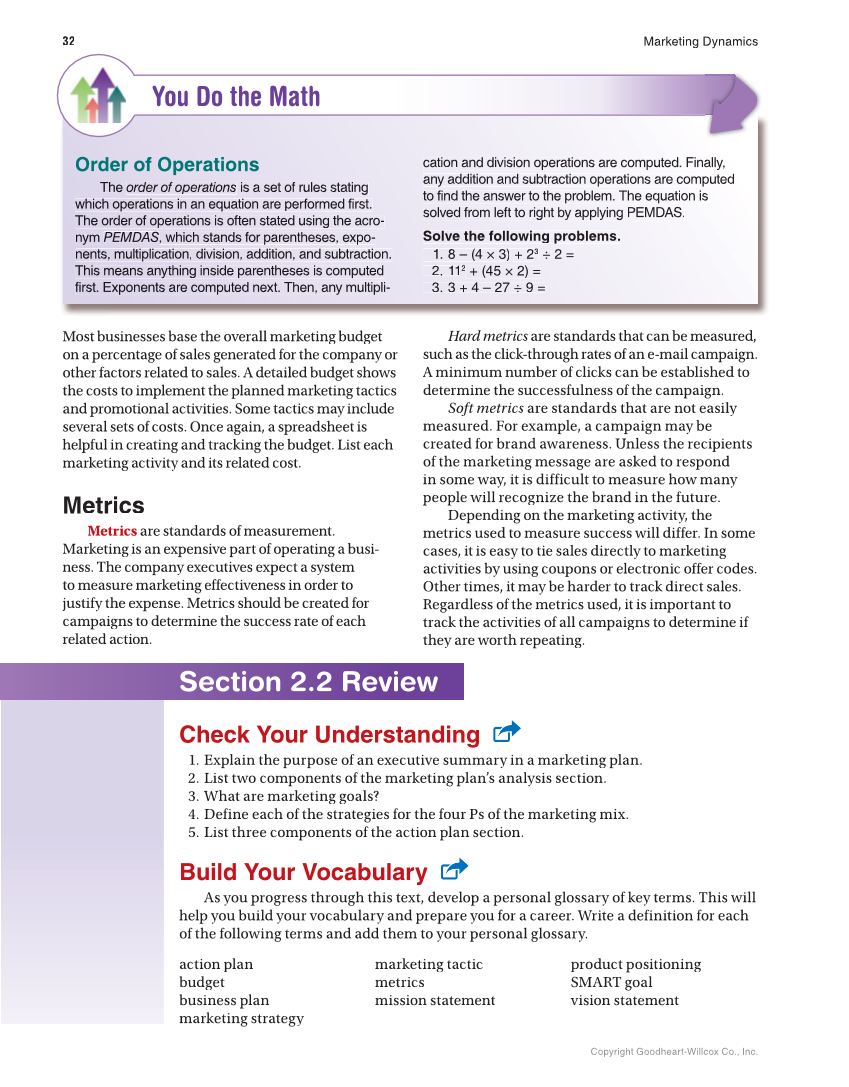32 Marketing Dynamics Copyright Goodheart-Willcox Co., Inc. Most businesses base the overall marketing budget on a percentage of sales generated for the company or other factors related to sales. A detailed budget shows the costs to implement the planned marketing tactics and promotional activities. Some tactics may include several sets of costs. Once again, a spreadsheet is helpful in creating and tracking the budget. List each marketing activity and its related cost. Metrics Metrics are standards of measurement. Marketing is an expensive part of operating a busi- ness. The company executives expect a system to measure marketing effectiveness in order to justify the expense. Metrics should be created for campaigns to determine the success rate of each related action. Hard metrics are standards that can be measured, s such as the click-through rates of an e-mail campaign. A minimum number of clicks can be established to determine the successfulness of the campaign. Soft metrics are standards that are not easily s measured. For example, a campaign may be created for brand awareness. Unless the recipients of the marketing message are asked to respond in some way, it is difficult to measure how many people will recognize the brand in the future. Depending on the marketing activity, the metrics used to measure success will differ. In some cases, it is easy to tie sales directly to marketing activities by using coupons or electronic offer codes. Other times, it may be harder to track direct sales. Regardless of the metrics used, it is important to track the activities of all campaigns to determine if they are worth repeating. Order of Operations The order of operations is a set of rules stating which operations in an equation are p rformed first. The order of operations r is often stated using the acro- nym PEMDAS, which hi stands for parentheses, expo- nents, multiplication, division, addition, and subtraction. This means anything inside parentheses is computed first. Exponents are computed next. Then, any multipli- cation and division operations are computed. Finally, any addition and subtraction operations are computed to find the answer to the problem. The equation is solved from left to right by applying PEMDAS. Solve the following f problems. 1. 8 – (4 × 3) + 23 ÷ 2 = 2. 112 + (45 × 2) = 3. 3 + 4 – 27 ÷ 9 = You Do the Math Section 2.2 Review Check Your Understanding 1. Explain the purpose of an executive summary in a marketing plan. 2. List two components of the marketing plan’s analysis section. 3. What are marketing goals? 4. Define each of the strategies for the four Ps of the marketing mix. 5. List three components of the action plan section. Build Your Vocabulary As you progress through this text, develop a personal glossary of key terms. This will help you build your vocabulary and prepare you for a career. Write a definition for each of the following terms and add them to your personal glossary. action plan budget business plan marketing strategy marketing tactic metrics mission statement product positioning SMART goal vision statement
